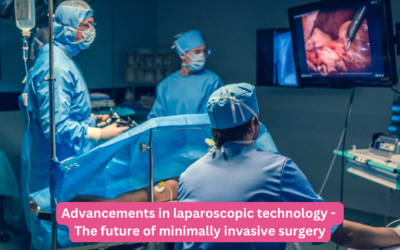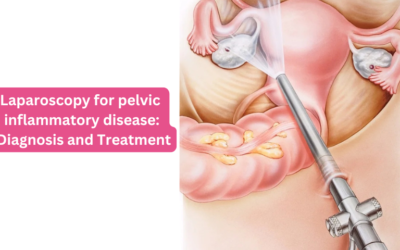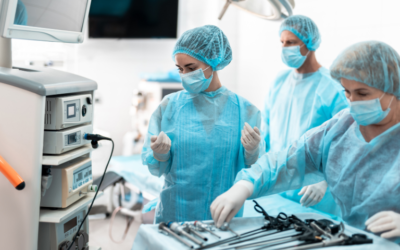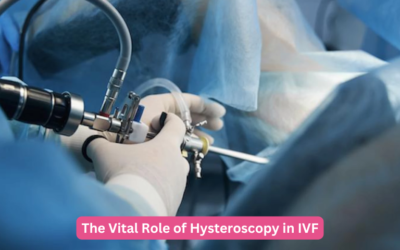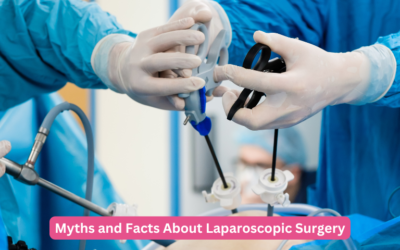What is Laparoscopic Myomectomy?
Laparoscopic myomectomy involves the removal of fibroids (non-cancerous growths) from the uterus using a laparoscope—a thin, flexible tube with a camera and surgical instruments attached. Unlike traditional open surgery, which requires a large incision, it is performed through small incisions, resulting in less pain, minimal scarring, and quicker recovery.
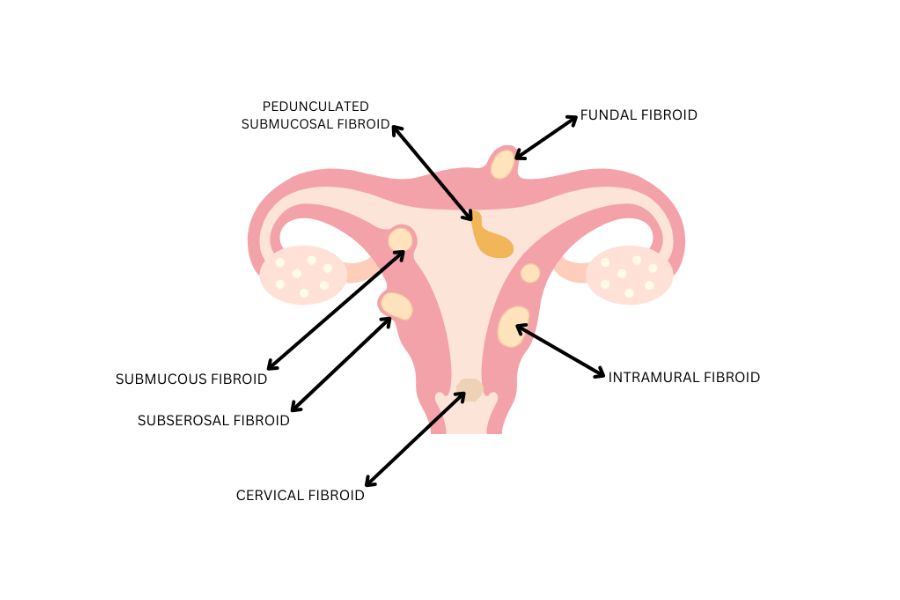
Types of Fibroids treated
- Submucosal fibroids: Located inside the uterine cavity.
- Intramural fibroids: Embedded within the muscular wall of the uterus.
- Subserosal fibroids: Projecting outside the uterus.
- Pedunculated fibroids: Attached to the uterus by a thin stalk.
Who needs a Laparoscopic Myomectomy?
Laparoscopic myomectomy is recommended for women who:
- Experience heavy menstrual bleeding.
- Suffer from pelvic pain or pressure.
- Have frequent urination or difficulty emptying the bladder.
- Encounter complications during pregnancy.
- Face infertility or recurrent miscarriages due to fibroids.
Eligibility for the procedure is determined through a thorough evaluation by our specialists, ensuring the best outcomes for our patients.
Benefits of Laparoscopic Myomectomy
- Minimally invasive nature: Small incisions lead to a less traumatic procedure with minimal blood loss.
- Reduced pain: Patients generally experience less postoperative pain compared to traditional open surgery.
- Faster recovery time: Most patients return to normal activities within a few weeks.
- Lower risk of complications: Smaller incisions reduce the risk of infection and other complications.
Laparoscopic Myomectomy Procedure
Pre-Surgery Preparations:
- Comprehensive medical evaluation and imaging tests (ultrasound, MRI).
- Detailed discussion of medical history and current medications.
- Instructions on preoperative fasting and cessation of certain medications.
Anaesthesia:
- General anaesthesia is administered to ensure the patient is asleep and pain-free during the procedure.
Surgical steps:
- Incisions: Small incisions (usually 5-10 mm) are made in the abdomen.
- Insertion of Laparoscope: A laparoscope is inserted through one of the incisions, providing a high-definition view of the uterus.
- Removal of fibroids: Specialized instruments are used to excise the fibroids, which are then removed through the incisions.
- Closure: The incisions are closed with sutures or surgical glue.
Duration:
- The procedure typically lasts between 1-3 hours, depending on the size and number of fibroids.
By understanding each step of the laparoscopic myomectomy, patients can approach their treatment with confidence, knowing that they are in capable hands at Shukan Hospital & IVF Centre.
Risks of Laparoscopic Myomectomy
While laparoscopic myomectomy is a generally safe procedure, it does carry potential risks, including:
- Bleeding: Though rare, excessive bleeding can occur.
- Infection: Small risk mitigated by sterile surgical techniques.
- Injury to nearby organs: Such as the bladder or intestines, although this is uncommon.
- Recurrence of fibroids: New fibroids can develop in the future.
At Shukan Hospital, we minimize these risks through meticulous surgical planning, advanced technology, and comprehensive pre-operative and post-operative care.
Why choose Shukan Hospital & IVF Centre in Ahmedabad for Laparoscopic Myomectomy?
- Our surgeons are highly skilled with extensive experience in laparoscopic techniques.
- We utilize the latest surgical equipment and techniques to ensure precision and safety.
- Each patient receives a tailored treatment plan to address their specific needs.
- Shukan Hospital is accredited and recognized for excellence in healthcare, ensuring you receive the highest standard of care.
FAqs
Will laparoscopic myomectomy affect my fertility?
It aims to preserve the uterus and, in many cases, can improve fertility by removing fibroids that may be causing infertility or recurrent miscarriages. However, individual outcomes can vary, and your surgeon will discuss the potential impacts on fertility based on your specific situation.
Will I have scars after the surgery?
Laparoscopic surgery involves small incisions, which typically result in minimal scarring. These small scars often fade over time and are much less noticeable compared to the large incision required for traditional open surgery.
Can all fibroids be removed laparoscopically?
Not all fibroids can be removed laparoscopically. The suitability depends on factors such as the size, number, and location of the fibroids, as well as the patient’s overall health and surgical history. Our specialists will assess your condition and determine the best surgical approach.
What can I do to speed up my recovery?
To facilitate a smooth recovery, follow your doctor’s postoperative care instructions, avoid heavy lifting, maintain a healthy diet, stay hydrated, and attend all follow-up appointments. Gentle activities like walking can aid in recovery, but strenuous activities should be avoided until your doctor gives the go-ahead.
Can fibroids recur after surgery?
While laparoscopic myomectomy effectively removes existing fibroids, it does not prevent new fibroids from developing. Regular follow-up visits and monitoring can help manage and detect any recurrence early.
What if I experience severe pain or complications after the surgery?
If you experience severe pain, fever, heavy bleeding, or any other concerning symptoms after the surgery, contact your doctor immediately or seek emergency medical care. Prompt attention to postoperative complications is crucial for your recovery.
What is the difference between laparoscopic myomectomy and hysterectomy?
A laparoscopic myomectomy involves the removal of fibroids from the uterus while preserving the uterus itself, which is ideal for women who wish to retain their fertility. In contrast, a hysterectomy involves the complete removal of the uterus and is typically considered when other treatments are not effective or appropriate.
How soon after the surgery can I try to conceive?
It is generally recommended to wait at least 3-6 months after a myomectomy before trying to conceive, to allow the uterus ample time to heal. However, your doctor will provide personalized advice based on your individual case and recovery progress.
How do I manage pain after laparoscopic myomectomy?
Pain management after surgery typically includes prescribed pain relievers, rest, and applying ice packs to the incision sites. Follow your doctor’s instructions for managing pain and contact them if the pain is severe or persistent.
Will I need to follow a special diet after the surgery?
While there are no strict dietary restrictions, it’s recommended to eat a balanced diet rich in fibre, fruits, and vegetables to aid recovery and prevent constipation. Staying hydrated is also important. Your doctor may provide specific dietary recommendations based on your condition.
Are there any lifestyle changes I should make after the surgery?
While no major lifestyle changes are typically required, it’s important to follow your doctor’s advice regarding activity levels, diet, and overall health. Gradually resuming physical activity and maintaining a healthy lifestyle can support your recovery and overall well-being.
How do I know if laparoscopic myomectomy is right for me?
Your eligibility for laparoscopic myomectomy depends on factors such as the size, number, and location of your fibroids, as well as your overall health and reproductive goals. A thorough evaluation by your doctor will determine the best treatment approach for you.
Can I drive myself home after the surgery?
No, you should arrange for someone to drive you home after the surgery, as you will not be able to drive due to the effects of anaesthesia and postoperative discomfort. It’s important to have someone with you to ensure your safety.
What should I bring with me to the hospital on the day of the surgery?
Bring your ID, insurance information, a list of current medications, comfortable clothing, and any personal items you may need. Your doctor will provide a detailed list of what to bring and how to prepare for your surgery.
Will I need any special equipment at home during my recovery?
Most patients do not need special equipment, but having comfortable clothing, pillows for support, and any prescribed medications readily available can help. Your doctor may provide specific recommendations based on your needs.
What if I experience emotional or psychological effects after the surgery?
It’s normal to experience a range of emotions after surgery. If you feel anxious or depressed, don’t hesitate to talk to your doctor. Support from friends, family, or a counsellor can also be beneficial during your recovery.
Testimonial Videos Related to Laparoscopy
Testimonials
Blogs related to Laparoscopy
Advancements in laparoscopic technology – The future of minimally invasive surgery
At the intersection of innovation and medicine, laparoscopic surgery has evolved from a promising technique into the gold standard of minimally...
Laparoscopy for pelvic inflammatory disease: Diagnosis and Treatment
Pelvic Inflammatory Disease (PID) is a serious infection of the female reproductive organs, including the uterus, fallopian tubes, and ovaries. Left...
The role of hysteroscopy in diagnosing and treating uterine abnormalities
At Shukan Hospital and IVF Centre, we are committed to providing comprehensive care for women’s reproductive health. One of the essential tools in...
The Wonder of Laparoscopy Surgery and its Benefits
Laparoscopy surgery, also known as minimally invasive surgery, has significantly transformed the landscape of modern medicine, particularly in the...
Preparing for Laparoscopic Surgery: Tips and Guidelines
Preparing for laparoscopic surgery involves several important steps to ensure a smooth and successful procedure. At Shukan Hospital and IVF Center,...
The Vital Role of Hysteroscopy in IVF
In the journey toward a successful in vitro fertilization (IVF) outcome, every step is crucial in ensuring the best possible results. One of the...
Myths and Facts About Laparoscopic Surgery
Laparoscopic surgery has become a popular choice for many types of operations due to its minimally invasive nature. However, several myths still...







